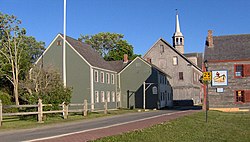South Shore

South Shore is an important fishing and tourism region of Nova Scotia. The tourism industry is concentrated in the towns of Lunenburg, Chester, Mahone Bay, Liverpool, the five beaches surrounding Riverport, and the fishing community of Peggy's Cove. Lunenburg, a UNESCO World Heritage Site and the host to several major music festivals and arts events, and the Bluenose II, is generally considered to be the cultural capital of the South Shore.
Cities
[edit]- 1 Bridgewater — the commercial centre and largest town, but not a tourist destination
- 2 Caledonia — a village close to Kejimkujik National Park, a true wilderness experience, 80% of which is only accessible by canoe or hiking trails
- 3 Chester — a holiday and resort destination, with many seasonal and year-round estates and mansions
- 4 Liverpool — an historic town and the "Port of the Privateers"
- 5 Lunenburg — home of the Bluenose II, a famous tall ship, its Old Town is on the UNESCO World Heritage List
- 6 Mahone Bay — a long-standing picturesque tourist destination set around a harbour
- 7 Shelburne — an historic town that is home of the Black Loyalist Heritage Centre & Historical Site
Other destinations
[edit]- 1 Kejimkujik National Park — one of the main attractions of the area. 381 km2 (147 sq mi) of protected forest. Keji provides the ultimate wilderness experience for the naturalist. 80% of the park is only accessible by canoe or hiking trails. Deer, porcupines, beavers, coyotes, martens and black bears are among the many species of wildlife you will find.
Understand
[edit]The South Shore was one of the first areas of North America to be colonized by Europeans following the French settlement at Port-Royal in 1605. The region, without good agricultural land, was only sparsely inhabited by the Acadians, although several settlements were established in present-day Shelburne County and the LaHave River valley. When the British took control of the region in 1713, they initiated a program of importing colonists from continental Europe, known as the Foreign Protestants, mostly from Germany and Switzerland. To this day the South Shore retains many German place names and surnames, and a distinct accent compared to the New England settlers' influence in the Annapolis Valley or the Highland Scots' influence in northeastern Nova Scotia and Cape Breton Island.
During the 20th century, the South Shore became the centre of Nova Scotia's fishing industry, as fishermen in small boats operated from numerous tiny villages dotted along the coast. The larger communities also had fish plants and port facilities for larger off-shore trawlers, which began to see increased use following the Second World War. During the 1960s and 1970s the impact of offshore processing and increasingly larger trawlers was being felt in communities, and the way of life on the South Shore was altered. As in many parts of Nova Scotia, many South Shore fishing communities all but disappeared as residents moved to larger urban centres in search of new opportunities. The decline in the fishery coincided with growth in the service industry, and specifically tourism.
The culture and economy along the South Shore gradually changed as the scenic area became a more common tourist destination. Coastal land prices rose, small businesses catering to the industry sprouted up, and a vibrant art community took root.
Get in
[edit]Most travellers flying into Nova Scotia enter through the Halifax Stanfield International Airport, 35 km (22 miles) from downtown Halifax. The airport is served by the major Canadian and American airlines, as well as many smaller regional airlines.
Queens County is on the southwestern coast of Nova Scotia, approximately 1½ hours drive from Halifax or Yarmouth along Highway 103.
Get around
[edit]The most effective means of touring the county is by car, as there is little in the way of public transit. The provincial scenic travel way, the "Lighthouse Route" runs on Trunk 3 through most centres along the shore.
See
[edit]
The Shelburne Historic Waterfont is a collection of authentic, restored original buildings that have been the locations for numerous films, including The Book of Negroes (2015, known as Someone Knows My Name in the U.S.).
The Black Loyalist Heritage Centre & Historical Site in Birchtown northwest of Shelburne tells the story of the first massive wave of Black immigration into Canada in 1783, when about 3,000 Black Loyalists fled New York City after aiding the British on the losing side of the American Revolutionary War and sailed to Nova Scotia.
The Bluenose II in Lunenburg is a replica of the original Bluenose featured on the back of Canadian dimes.
Do
[edit]Enjoy the many pristine white sand beaches of Queens County's near Liverpool.
Explore the beautiful Kejimkujik National Park on foot or in a canoe.


 Français
Français Italiano
Italiano




